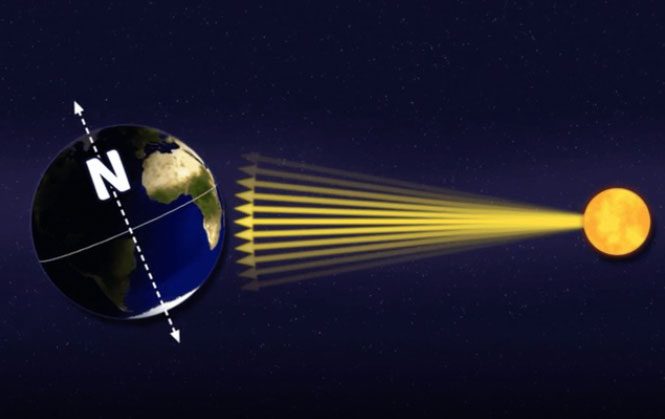Today, December 22, 2022, marks the winter solstice in the Northern Hemisphere. In Eastern culture, this day represents the midpoint of winter, being the shortest day and longest night of the year.
The Winter Solstice is a point, not a day
Mr. Đặng Vũ Tuấn Sơn, from the Vietnam Astronomical Association, states that the winter solstice for the Northern Hemisphere is the moment when the Sun reaches its furthest point (as observed) to the South before shifting back to the North.
In English, the two solstices (the summer and winter solstices) are collectively referred to as solstice, which is derived from the Latin words sol (Sun) and sistere (to stand still), indicating the point at which the apparent path of the Sun halts to change direction. The winter solstice, for the Northern Hemisphere, occurs when the Sun reaches its highest declination (DEC) in the Southern Hemisphere and then begins to rise back towards the North. At this time, the rays of the Sun shine directly down on the Tropic of Capricorn.
In reality, in modern astronomy, the winter solstice is a point rather than a day. The day referred to as the winter solstice is simply the one that contains that point. The winter solstice point for the year 2022 occurs at 4:48 AM on December 22, Vietnam time, which corresponds to 21:48 UTC on December 21. This means that countries with time zones at least 5 hours behind Vietnam (from GMT+2 onward) will identify the “winter solstice day” as December 21.

December 22, 2022, is the winter solstice, the shortest day of the year due to minimal sunlight.
The term “winter solstice” in Vietnamese is derived from the name of the winter season in the 24 solar terms (specifically, 12 solar terms and 12 interstitial terms, but commonly referred to as 24 terms), which originated in China. According to the 24 solar terms calendar, each term lasts 15 or 16 days, and the winter solstice term begins at the same time as the winter solstice in modern astronomy.
However, in modern astronomy, the winter solstice is merely a point, thus it differs from the concept of the winter solstice term in Eastern culture.
At the winter solstice, the Southern Hemisphere receives the most solar radiation (making it summer there), while the Northern Hemisphere receives the least. Since the daylight duration for any point in the Northern Hemisphere is shortest at this time, the days surrounding the winter solstice are the days with the shortest daytime and longest nighttime in the Northern Hemisphere.
It is also important to note that the assumption that the winter solstice must be the coldest day is inaccurate. Although the duration of sunlight significantly affects temperature, the weather conditions of different regions at any given time depend on many other factors occurring in the atmosphere and oceans (rain, wind, clouds, atmospheric composition and density, ocean currents, etc.).
Calculating the Start Date of the Seasons
Most Vietnamese assume that the solar terms follow the Lunar calendar. This is incorrect. The Lunar calendar is based on the lunar cycle, where 12 lunar months (12 lunar weeks) make up a year. However, the weather cycle primarily depends on the Earth’s orbit around the Sun – since the Sun is the main heat source for the Earth, while the Moon has no relation to this. The Earth’s orbital period is approximately 10 days longer than the total length of 12 lunar weeks.
Consequently, the Easterners later added a leap month, which is the 13th month in the Lunar calendar. Typically, every three years, there is one year that includes this month, allowing the Lunar calendar to keep pace with the weather cycle.
Due to the aforementioned discrepancy, the Lunar calendar does not accurately reflect the weather cycle. However, due to a lack of understanding, many people often apply folk experiences that are merely relative to predict the weather. For instance, “July is the month of rainy weather” is a relative experience. The seventh month in the Lunar calendar is not a precise time frame and varies each year by 10 to 20 days compared to the seventh month of two consecutive years.
In Northern Vietnam and many other regions, the autumn period often experiences light but prolonged rains, commonly referred to as drizzle rain in folk terms. There is no basis to assert that it only occurs in the seventh month of the Lunar calendar, nor that it must occur within a specific timeframe of half a month or a month.
Thus, such experiences are merely references and do not hold predictive value for the weather. Meanwhile, the 24 solar terms do not rely on the Lunar calendar, but solely on the weather cycle. The 24 solar terms represent 24 time segments, each lasting 15 or 16 days, describing 24 different weather phases throughout the year.
Because this cycle depends on the Earth’s position in orbit, it closely aligns with the Gregorian calendar. Most Vietnamese today still refer to when the spring festival will begin next year, but in reality, it always falls on February 4th or 5th in the Gregorian calendar. The same applies to other terms.
However, stating that the 24 solar terms belong to the Gregorian calendar would also be incorrect. When we say a system of conventions belongs to a certain type of calendar, we are discussing history. The Gregorian calendar, as we know it today, is accurately referred to as the Gregorian Calendar, issued by Pope Gregory XIII at the end of the 16th century, slightly modified from the earlier Julian calendar (Julian Calendar) – Of course, the timeline in the calendar is determined by astronomers who observe and systematize it; neither Caesar nor the Pope were astronomers capable of doing this themselves. The 24 solar terms were established by the Chinese, thus they do not belong to the Gregorian calendar.
The starting days of the solar terms and solstices (the four solstice days in the Gregorian calendar) are considered the midpoints of the seasons. However, in Western culture, these solstice days mark the beginnings of the seasons.
The differences in seasonal calculation points do not affect the modern world at all, as they are purely cultural. Just because you call this time summer or autumn does not mean the weather and atmosphere must change accordingly.


















































